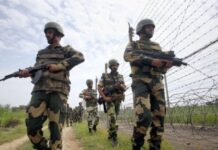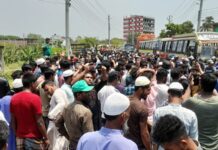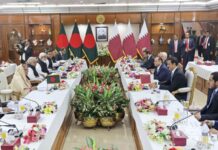Erasure, power, and representation

Let us not romanticize the struggle of those who wish to go home for Eid
Twice every year, an exodus of massive proportions breaks out from the capital city of Bangladesh. Twice every year, contradictions emerge between the interpretation offered for the challenges riddling the home-going ritual by corporations and the mainstream media, and that which bears the facts.
As is characteristic of most mass departures, the two in question not only subject their constituents to a multicourse assortment of suffering drawn out from the ticket sales in the preceding weeks all the way to the actual journey itself but, more importantly, are natural consequences to an ill-equipped system being tasked with the dispatch of as many as six million people to different corners of the country within the span of a week prior to the Eid festival, often less.
To put things into perspective, even in the most recent chapter of the festival and its corresponding urban desertion, congestion on national highways, rail track derailments, and inadequacy of ferries were dreadful enough to instigate furious demonstrations atop expressways, prompting toll collection on the Bangabandhu bridge to be suspended at least thrice, birthing further tailbacks in turn.
Needless to say, as with all past home-rushes, this year’s Eid-ul-Azha remained unaffected by any of the discernible upgrade predicted to ensue following the extensive proclamations of the nationwide “development” narrative.
How then does the state, or any of its instruments invested in the advocacy of the aforementioned model, explain this perpetual ordeal? Apparently, through apologies, newspeak, and deflections of blame.
While the Road Transport and Bridges minister sought to pacify widespread frustration with a note of apology, the minister of railways opted to attribute the department’s impotence to “excessive” numbers, practically gaslighting the passengers, while also presenting the completion of a new bridge in 2023 as the hypothetical resolution of the crisis as a buffer for ongoing passenger discontentment.
However, despite the supposedly universal acknowledgement of the horrendous state of the transportation system, the representations of the tedious journey offered on billboards and screens seem to disagree, and even when they don’t, they appear far more interested in synthesizing connotations in the vein of cathartic, the-silver-lining-though implications.
Confirming sociologist Theodor Adorno’s postulations from decades ago, “the culture industry,” as we know it, repackages an insufferable predicament — the institutions liable for which are well-known by the masses — into a phenomenon that requires to be viewed through a romanticized, Sisyphean lens.
Tailbacks of a hundred kilometres become rewritten as opportunities for communal togetherness to foster, fathers missing rides back home to their children become fertile backdrops for mobile internet speeds to be flaunted.
Parallel to the erasure and redefinition of the home-going experience, several other misguided notions, usually emanating from petit-bourgeois echelons, begin to sprout during this time, the most popular and recurring being the one concerned with “the overpopulation problem.”
Although initially derived from the mere observation of just how much more satisfactory commuting through Dhaka becomes during Eid, the descent into an obsession with a Malthusian analysis of the city’s fundamental problems soon begins to evolve into an ignorant, classist rhetoric pitted against the non-Dhakaiya working class for simply existing within the city’s walls.
While overpopulation in Dhaka is a pressing concern that certainly requires urgent intervention, the popular takes on the issue say very little about the causation and sustenance of the influx and the subsequent “development” ramped up in order to provide accommodation.
By individualizing blame, as it did in response to the road safety movement and the series of mob lynchings, the state avoids having to answer for endorsing and contributing to the creation of environments where productivity is prioritized over measures to make workplaces and living conditions more humane than mere slave quarters.
As a result, you find a dehumanizing society that exists solely to produce value and house those that the system requires to do so.
As Manosh Chowdhury, professor of anthropology at Jahangirnagar University, remarks, Dhaka is practically a skeleton of a city where one would never walk down a particular road twice unless it coincides with their route to work, where the human beings are reduced to mere consumers going in and out of their rented apartments to essentially “consume” and to desperately exercise predefined formats of “socialization,” “self-care,” and often even “worship” — all within the parameters of capitalist realism.
Redefining the failings of the ruling socioeconomic and political order has the enormous benefits of gaslighting constituent citizens — be it into adopting consumerist indulgence as means of therapy or into accepting incoherent populist tirades as legitimate political and moral direction.
Consequently, public spaces — particularly those that used to serve as platforms for political dissent — are encroached upon to make room for train routes while “dissent” itself becomes a “civilized,” “West-inspired” activity to be conducted in air-conditioned rooms along with peers in suits; commuters are reprimanded for not making use of the bizarre structures erected to alleviate gridlocks born from horrendous urban planning, and even the most fundamental phenomenon of nature is recharacterized as an inauspicious happening responsible for the flooding of thoroughfares as opposed to the poor drainage and infrastructure of the city.
We see, therefore, that a true resolution of the obstacles to our supposed definition of a utopia — one built in the vein of the seemingly favorable city we find on Eid — has to not only repoliticize the conversation beyond romantic interpretations of “going home to loved ones, no matter the cost,” but has to involve a profound critique of power and capital while also challenging the ruling ontology of what it means to be human in a world moulded out of the global north’s “enlightened”, “modern” models.
We must begin to imagine a political and socioeconomic reality beyond the alienating status quo that sees looming towers and industrial fumes threatening to consume everything, nothing evading the iron fist of an era where monetary and material proliferation begin overshadowing our primary needs and struggles.
Sayrat Salekin considers himself to be a student. His other texts can be found on his Medium profile.









